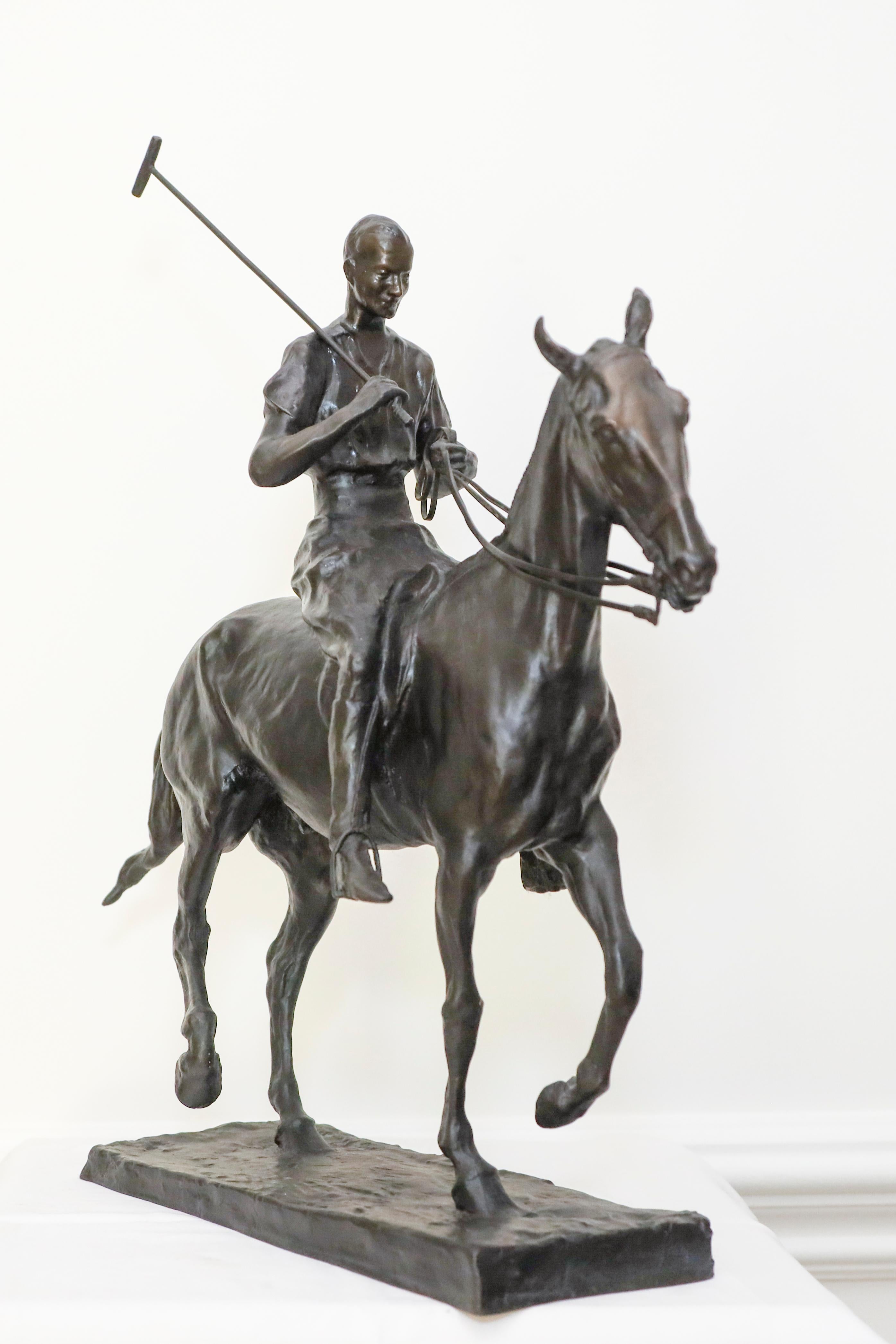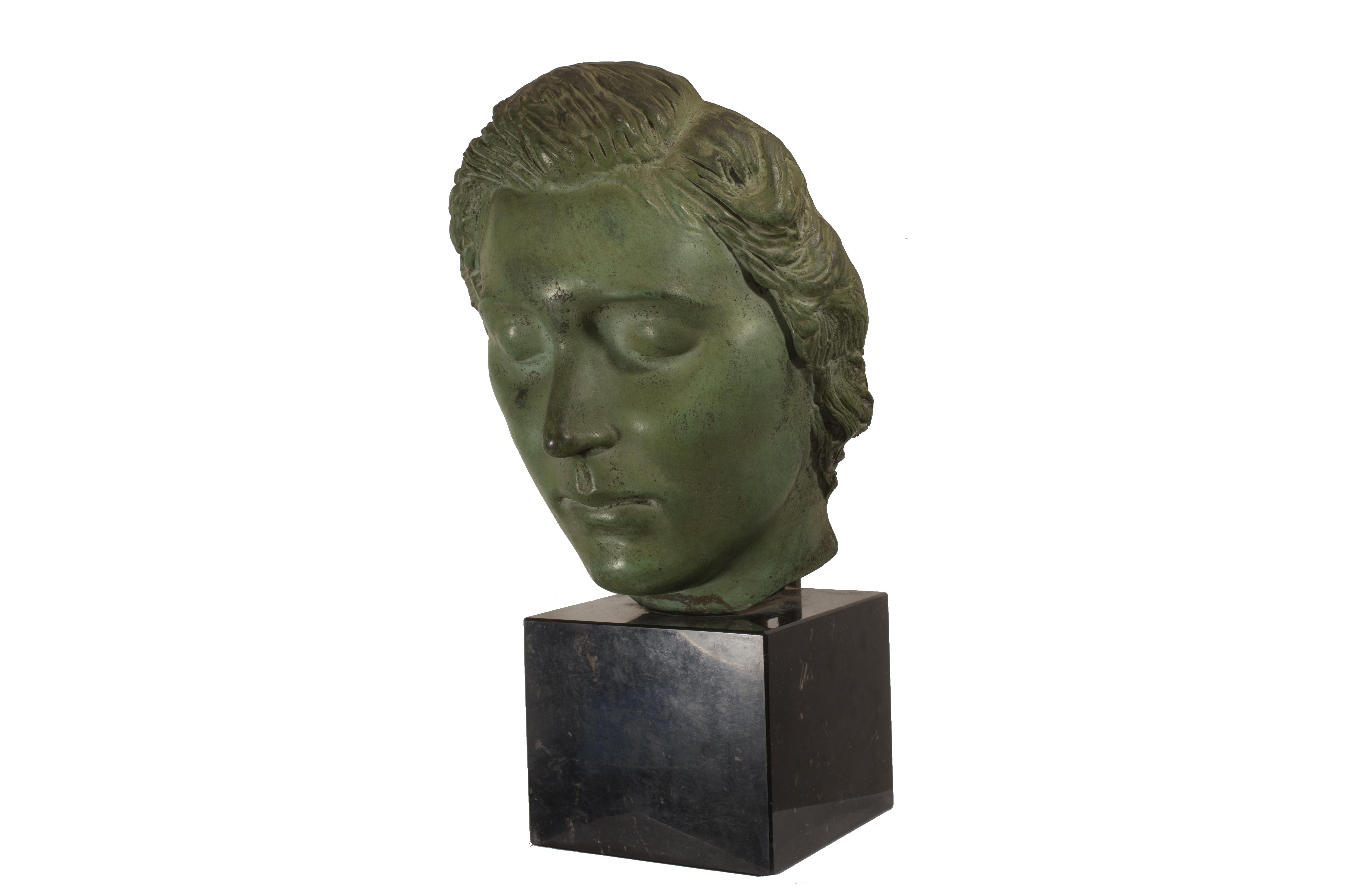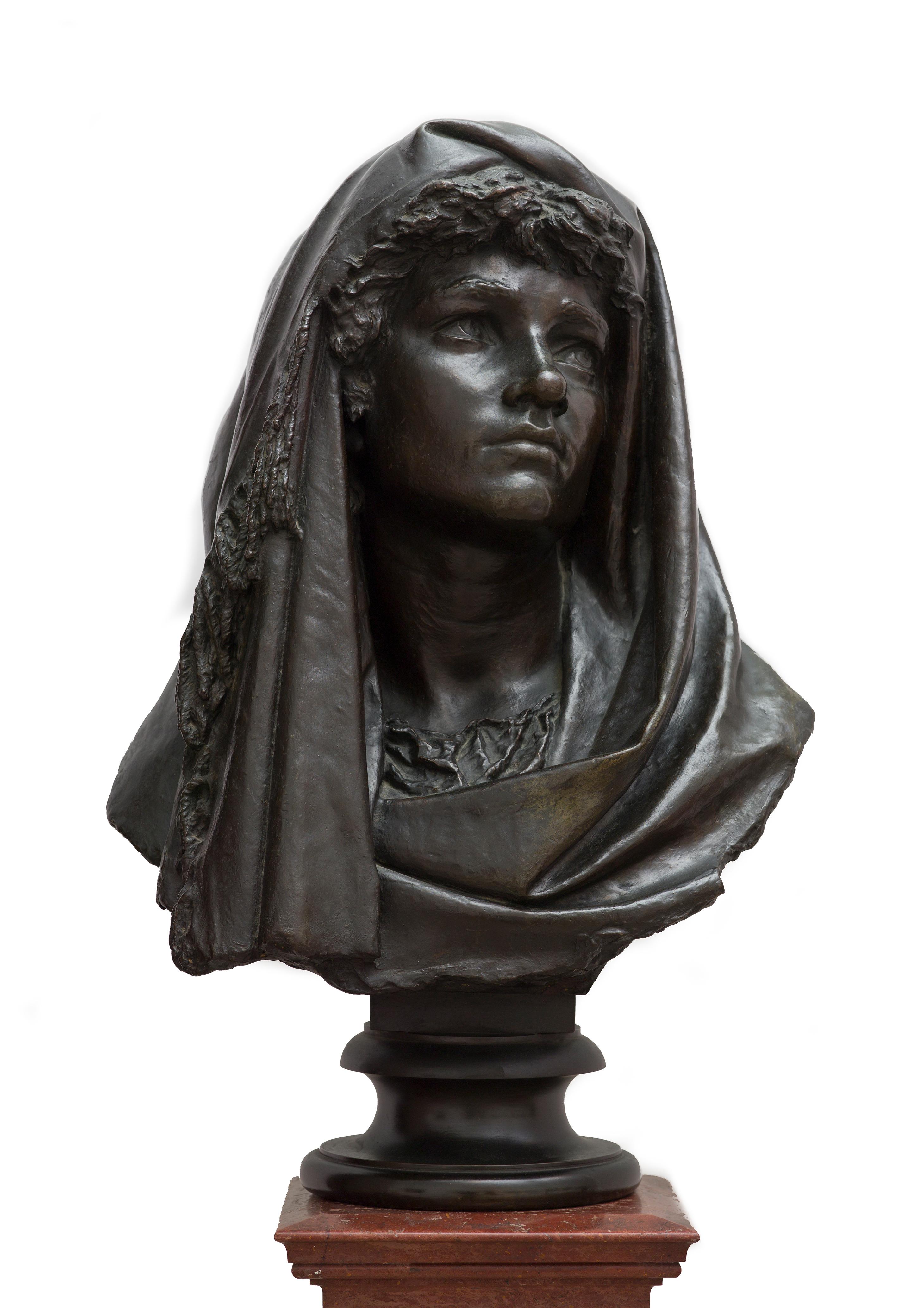Items Similar to Girardon’s Equestrian Portrait of Louis XIV
Want more images or videos?
Request additional images or videos from the seller
1 of 8
Girardon’s Equestrian Portrait of Louis XIVCirca 1820
Circa 1820
About the Item
King Louis XIV, one of France's greatest monarchs, sits confidently astride a prancing steed in this bronze equestrian statue. The extraordinary work is a reduction of the portrait of the Sun King by François Girardon, one of the most noted and influential sculptors of the period. Looking back to the great masterpieces of antiquity, Girardon took his inspiration from the seminal ancient Roman marble of Marcus Aurelius, now in the Musei Capitoline (Rome). Louis XIV is thus portrayed here as a conquering Roman hero, his costume adorned with many neoclassical motifs, hand outstretched in a gesture of command. The result is an imposing royal portrait of power and absolute authority that pays homage to one of the most important sovereigns in French history.
It was in 1685, at the very height of his rule, when Louis XIV commissioned the monumental bronze of himself from the great Girardon. As sculptor to the king, Girardon was a key figure in the decoration of the gardens at the Château de Versailles, and he was later commissioned to complete several important royal projects, this equestrian sculpture included. The bronze was erected in the Place Louis-le-Grand (now the Place Vêndome) in 1699, but was regrettably destroyed less than a century later during the French Revolution in 1792. One small section of the original does remain — the left foot of the king, which is now held in the Musée Carnavalet (Paris).
Luckily, Girardon recognized the importance of his creation and executed four bronze reductions of the sculpture. Today, three of these four can be found in the British Royal Collection (London), the State Hermitage Museum (St. Petersburg) and the Louvre. The example in the Louvre is the only signed reduction cast by Girardon.
Since the 17th century, other reductions of the work has been created, including the present bronze, which dates to the late 19th century. Parisian bronziers such as Henri Dasson and Alfred Beurdeley were among the important makers who re-created the sculpture during this period, and this could have come from their workshops. It is a stunning ode to this great monarch, reflection the glory of his reign and the glory of France.
The archetype of absolutism in royalty, the 72-year reign of Louis XIV, the longest in European history, not only enhanced the power of the monarchy, but catapulted France to become the most powerful nation in Europe. Louis XIV built Versailles during his reign to reflect the grandeur of the King and his court which ruled under the belief, "One King, One Law, One Faith." The period during which he served as King of France became known as "The Age of Louis XIV."
Circa 1820
Sculpture: 36" wide x 19" deep x 43" high
Base: 37 1/4" wide x 25" deep x 30" high
Total: 37 1/4" wide x 25" deep x 73" high
- Creation Year:Circa 1820
- Dimensions:Height: 43 in (109.22 cm)Width: 36 in (91.44 cm)Depth: 19 in (48.26 cm)
- Medium:
- After:François Girardon
- Period:
- Condition:
- Gallery Location:New Orleans, LA
- Reference Number:
About the Seller
5.0
Vetted Seller
These experienced sellers undergo a comprehensive evaluation by our team of in-house experts.
Established in 1912
1stDibs seller since 2013
15 sales on 1stDibs
Typical response time: 4 hours
- ShippingRetrieving quote...Ships From: New Orleans, LA
- Return PolicyThis item cannot be returned.
More From This SellerView All
- Winston Churchill Artist Proof Bust by Ivor Roberts-JonesBy Ivor Roberts-JonesLocated in New Orleans, LAIvor Roberts-Jones 1916-1996 British Sir Winston Churchill Artist Proof Bronze with a green patina One of the greatest leaders of the modern world, Winston Churchill is among the...Category
20th Century Figurative Sculptures
MaterialsBronze
- Laocoön And His Sons By Adriaen De VriesLocated in New Orleans, LAAdriaen de Vries 1556-1626 Dutch Laocoön and His Sons Bronze A remarkable feat of artistry and skill, this bronze sculpture was created by famed Dutch artist Adriaen de Vries. Full of the swelling emotions and dramatic posing so quintessential to the period, the bronze is a masterclass in Baroque sculpture. The original Laocoön marble sculpture, after which this remarkable bronze was modeled, unquestionably influenced the lives and works of countless artists, authors, popes, kings and emperors since its re-discovery in 1506. Famously, Michelangelo declared the sculpture, created circa 35 BC, as the “greatest piece of art in the world.” Adriaen de Vries, an apprentice of the great sculptor Giambologna, undoubtedly sought to prove his skill and creative voice with his own depiction of this most famous scene. Known for his virtuosic casting technique, this rare and important sculpture embodies de Vries’ mastery. The story of Laocoön is one of the most famous in all of literature. As told by the poet Virgil, the Greeks, after an unsuccessful ten-year siege on the city of Troy, the Greeks craftily left a giant wooden horse outside the gates...Category
16th Century Baroque Figurative Sculptures
MaterialsBronze
- THE LAST DAYS OF NAPOLÉON BYLocated in New Orleans, LAThis highly evocative bronze by Vincenzo Vela captures the deposed Emperor Napoléon on his deathbed, holding a map of Europe and lost in thought about what might have been. Remarkable among most portrayals of the exiled leader, this highly detailed sculpture depicts Napoléon at his most vulnerable. Nonetheless, Vela perfectly captures his still-heroic bearing, which imparts to this work a monumental quality and quiet dignity. The mate to this figure is the colossal marble at the Musée du Château de Malmaison, which was shown at the Paris Salon of 1867. The founder of the verismo movement in Italy, Vela was one of the great exponents of realism in sculpture. Born in Ligornetto, Switzerland in 1820, he studied under celebrated sculptor, Benedetto Cacciatori. He was also influenced both by the work of Tuscan sculptor Lorenzo Bartolini, who seamlessly combined neoclassicism with naturalism and the romantic painting of Francesco Hayez...Category
19th Century Realist Figurative Sculptures
MaterialsMarble, Bronze
- How They Met Themselves By John Singer SargentBy John Singer SargentLocated in New Orleans, LAJohn Singer Sargent 1856-1925 American How They Met Themselves Bronze John Singer Sargent was among the most successful artists of his era. By the late 19th century, he was the m...Category
Early 20th Century Post-Impressionist Figurative Sculptures
MaterialsBronze
- CoupleBy Agustín CárdenasLocated in New Orleans, LAInfused with a crisp modernity and subtle sensuality, this bronze sculpture by Cuban-born artist Agustin Cárdenas is an exceptional example of late-2...Category
20th Century Modern Figurative Sculptures
MaterialsMarble, Bronze
- Bronze of Pluto Abducting Proserpine after François GirardonLocated in New Orleans, LAAfter François Girardon 1628-1715 French Pluto Abducting Proserpine Bronze This High Baroque period composition captures the famed narrative of Pluto and Proserpine from Roman mythology. The late 17th-century patinated bronze, created after François Girardon's marble composition, captures the very moment that Pluto seizes Proserpine. The anguished goddess reaches skyward, attempting to escape the god’s grasp while Pluto’s stoic face betrays his knowledge that his ploy will succeed. This pivotal moment in the mythological tale has captured the imagination of many art historical greats, from Bernini to Rubens. François Girardon’s version of the climax demonstrates incredible finesse and artistry, modeled expertly in bronze in the present work by a later sculptor. The statue brings a twist of intertwined bodies into a dynamic frenzy, paralleling the tension of the legendary story. In ancient Roman mythology, Proserpine, the beautiful daughter of Ceres — known as Persephone in Greek mythology — was picking flowers in the fields when she was suddenly abducted by Pluto, the god of the underworld, and taken to his kingdom. Consumed with grief, her mother Ceres, the goddess of agriculture, scorches the earth, stopping the growth of grain and fruit. Jupiter attempts to intervene and secure Proserpine’s return to earth, negotiating a compromise with Pluto and the Fates that allows Proserpine to be released for part of the year before returning to Pluto’s underworld. Proserpine’s journey back and forth is an allegory for the changing seasons; when Prosperine is with her mother, the earth warms and provides bountiful harvests. Upon her annual return to the underworld, however, the earth once again becomes cold and barren. After returning to France after years of training in Rome, François Girardon quickly rose to become one of the greatest artists in France. He was elected a member of the Académie Royale de Peinture et de Sculpture in 1657 and would become Chancellor of the Royal Academy in 1695. The artist was approached frequently for royal commissions and Girardon’s Pluto was originally commissioned by Louis XIV for the gardens at his Palace of Versailles. It was one of four monumental marble groups intended to decorate the corners of Charles Le Brun’s never completed garden at the chateau, the Parterre d’Eau. Each group of three figures symbolized one of the four elements: earth, air, fire and water. Pluto’s association with hell made him the apt...Category
Early 18th Century Baroque Figurative Sculptures
MaterialsBronze
You May Also Like
- [Bruce Sargeant (1898-1938)] Statue of an AthleteBy Mark BeardLocated in New York, NYThis artwork is offered by ClampArt, located in New York City. “Bruce Sargeant is a mythic figure in the modern art movement. He embodies a world that is in many ways lost to us; he...Category
21st Century and Contemporary Realist Figurative Sculptures
MaterialsBronze
- Sculpture of a Polo Player Harrison Tweed by Charles RumseyBy Charles Cary RumseyLocated in Brookville, NYPolo Pony and Rider Harrison Tweed . Charles Rumsey was an 8 goal polo player with Meadowbrook Polo Club on Long Island NY. He was an avid sportsman, equestrian and artist. His ab...Category
1910s Abstract Impressionist Figurative Sculptures
MaterialsBronze
- Female faceLocated in Roma, RMAlfredo Biagini (Rome 1886 - 1952), Female Face Bronze sculpture 23 x 17 x 21 cm signed at bottom.Category
Early 20th Century Other Art Style Figurative Sculptures
MaterialsBronze
- Bust of veiled womanLocated in Roma, RMGiulio Tadolini ( Rome 1849 - 1918 ) ( attr. to ), Bust of veiled woman Bronze 61 x 37 x 22 cm.Category
Late 19th Century Academic Figurative Sculptures
MaterialsBronze
- Lying Body by Sergio Monari 1985 Figurative Sculpture Patinated Bronze CastBy Sergio MonariLocated in Brescia, ITBronze artwork made with lost wax casting technique. This is the prototype, unique signed artist proof. Sergio Monari is an Italian sculpture, that liv...Category
1980s Post-Minimalist Figurative Sculptures
MaterialsBronze
- 1985 Figurative Sculpture Patinated Bronze Cast Sergio MonariBy Sergio MonariLocated in Brescia, ITBronze artwork made with lost wax casting technique. This is the prototype, unique signed artist proof. Title "Sleeping body" Sergio Monari is an Italia...Category
1980s Post-Minimalist Figurative Sculptures
MaterialsBronze
Recently Viewed
View AllMore Ways To Browse
Louis Style Art
Louis Xiv Antique
Antique Key Art
Antique Sculptures London
Francois 1
Antique Bronze Portrait
Antique Equestrian Equestrian
Antique Equestrian
Ancient Roman Marble
Equestrian Original
Equestrian Gold
King Louis Xiv
Chateau De Versailles
Antique Monarch
Ancient Roman Figure
King Louis Marble
Equestrian Bronze
British Royalty
![[Bruce Sargeant (1898-1938)] Statue of an Athlete](https://a.1stdibscdn.com/mark-beard-sculptures-bruce-sargeant-1898-1938-statue-of-an-athlete-for-sale-picture-2/a_9323/a_35855421542990089601/Statue_of_an_Athlete_installation_crop_artnet_master.jpg)


